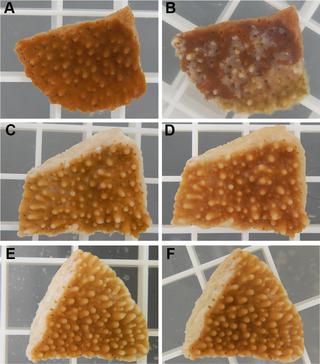PLOS ONE ( IF 2.9 ) Pub Date : 2018-06-19 , DOI: 10.1371/journal.pone.0199475 Blake Ushijima , Gary P. Richards , Michael A. Watson , Carla B. Schubiger , Claudia C. Häse

|
The bacterium Vibrio coralliilyticus can threaten vital reef ecosystems by causing disease in a variety of coral genera, and, for some strains, increases in virulence at elevated water temperatures. In addition, strains of V. coralliilyticus (formally identified as V. tubiashii) have been implicated in mass mortalities of shellfish larvae causing significant economic losses to the shellfish industry. Recently, strain BAA-450, a coral pathogen, was demonstrated to be virulent towards larval Pacific oysters (Crassostrea gigas). However, it is unclear whether other coral-associated V. coralliilyticus strains can cause shellfish mortalities and if infections are influenced by temperature. This study compared dose dependence, temperature impact, and gross pathology of four V. coralliilyticus strains (BAA-450, OCN008, OCN014 and RE98) on larval C. gigas raised at 23°C and 27°C, and evaluated whether select virulence factors are required for shellfish infections as they are for corals. All strains were infectious to larval oysters in a dose-dependent manner with OCN014 being the most pathogenic and BAA-450 being the least. At 27°C, higher larval mortalities (p < 0.05) were observed for all V. coralliilyticus strains, ranging from 38.8−93.7%. Gross pathological changes to the velum and cilia occurred in diseased larvae, but there were no distinguishable differences between oysters exposed to different V. coralliilyticus strains or temperatures. Additionally, in OCN008, the predicted transcriptional regulator ToxR and the outer membrane protein OmpU were important for coral and oyster disease, while mannose sensitive hemagglutinin type IV pili were required only for coral infection. This study demonstrated that multiple coral pathogens can infect oyster larvae in a temperature-dependent manner and identified virulence factors required for infection of both hosts.
中文翻译:

影响溶珊瑚弧菌感染珊瑚和幼体牡蛎的因素
细菌弧菌coralliilyticus可以通过在各种珊瑚属的致病威胁生命珊瑚礁生态系统,而且,对于一些菌株,在升高的水温增加的毒力。另外,V的应变。coralliilyticus(正式确定为V。tubiashii)有牵连造成显著的经济损失贝类产业贝类幼体大量死亡。最近,已证明珊瑚病原体BAA-450菌株对幼体太平洋牡蛎(Crassostrea gigas)有毒。但是,目前还不清楚是否有其他的珊瑚相关的V。溶珊瑚菌株可能导致贝类死亡,以及感染是否受温度影响。这项研究比较了4 V的剂量依赖性,温度影响和总体病理。幼虫C上的coraloliilyticus菌株(BAA-450,OCN008,OCN014和RE98)。在23°C和27°C的温度下饲养的巨as,并评估是否需要选择毒性因子来进行贝类感染,就像对珊瑚一样。所有菌株均以剂量依赖性方式感染幼虫牡蛎,其中OCN014的致病性最高,BAA-450的致病性最低。在27°C下,所有V的幼虫死亡率都较高(p <0.05)。溶珊瑚毒株,范围从38.8−93.7%。在患病的幼虫中,出现了大体上的病变,直至发膜和纤毛,但暴露于不同V的牡蛎之间没有明显的差异。Coralliilyticus菌株或温度。此外,在OCN008中,预测的转录调节因子ToxR和外膜蛋白OmpU对珊瑚和牡蛎疾病很重要,而甘露糖敏感的IV型血凝素菌毛仅对珊瑚感染有用。这项研究表明,多种珊瑚病原体可以以温度依赖性方式感染牡蛎幼虫,并确定了感染两个宿主所需的毒力因子。











































 京公网安备 11010802027423号
京公网安备 11010802027423号